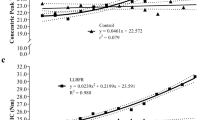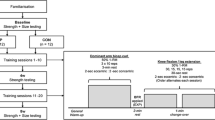Abstract
Purpose
Low-load venous blood flow restriction resistance training (RT + BFR) has been demonstrated to increase muscle strength to a greater degree than low-load non-BFR resistance training (RT) during isotonic training, but no previous investigations have examined RT + BFR versus RT during isokinetic training. The purpose of the present study was to examine the effects of 4 weeks of isokinetic low-load RT + BFR versus low-load RT on indices of muscle strength, muscle size, and neural adaptations.
Methods
Thirty women (mean ± SD; 22 ± 2 years) participated in this investigation and were randomly assigned to 4 weeks of either RT + BFR (n = 10), RT (n = 10), or control (n = 10) group. Resistance training consisted of 75 reciprocal forearm flexion–extension isokinetic muscle actions of the forearm flexors performed at a velocity of 120°s−1.
Results
Concentric peak torque increased to a greater extent for RT + BFR after 4 weeks (36.9%) compared to RT (25.8%), but there were similar increases in isometric torque (23.3–42.1%). For both RT + BFR and RT, there were similar increases in muscle cross-sectional area and muscle thickness of the biceps brachii after 2 weeks (11.3–14.3% and 12.4–12.9%, respectively) and 4 weeks (18.7–21.9% and 19.0–20.0%, respectively). There were similar increases in mechanomyographic amplitude, mechanomyographic mean power frequency, and electromyographic mean power frequency, but no changes in electromyographic amplitude for all conditions (including control).
Conclusions
These findings indicated that low-load RT + BFR elicited greater increases in concentric strength than low-load RT, but elicited comparable increases in isometric strength and muscle size. There were also no differences in any of the EMG and MMG responses among conditions.





Similar content being viewed by others
Abbreviations
- BFR:
-
Venous blood flow restriction
- DCER:
-
Dynamic constant external resistance
- EMG:
-
Electromyography
- MVIC:
-
Maximal voluntary isometric contraction
- MMG:
-
Mechanomyography
- RT:
-
Resistance training
- RT + BFR:
-
Resistance training with blood flow restriction
References
Abe T, Yasuda T, Midorikawa T, Sato Y, Kearns CF, Inoue K, Koizumi K, Ishii N (2005) Skeletal muscle size and circulating IGF-1 are increased after two weeks of twice daily KAATSU resistance training. Int J KAATSU Train Res 1(1):6–12
American College of Sports Medicine (2009) Progression Models in Resistance Training for Healthy Adults. Med Sci Sports Exerc 41(3):687–708
Arts IM, Pillen S, Schelhaas HJ, Overeem S, Zwarts MJ (2010) Normal values for quantitative muscle ultrasonography in adults. Muscle Nerve 41(1):32–41
Barbero M, Merletti R, Rainoldi A (2012) Atlas of muscle innervation zones understanding surface electromyography and its applications. Springer, New York
Bartolomei S, Hoffman JR, Stout JR, Merni F (2018) Effect of lower-body resistance training on upper-body strength adaptation in trained men. J Strength Cond Res 32(1):13–18
Beck TW, Housh TJ, Cramer JT, Weir JP, Johnson GO, Coburn JW, Malek MH, Mielke M (2005) Mechanomyographic amplitude and frequency responses during dynamic muscle actions: a comprehensive review. Biomed Eng Online 4:67
Behringer M, Heinke L, Leyendecker J, Mester J (2018) Effects of blood flow restriction during moderate-intensity eccentric knee extensions. J Physiol Sci 68(5):589–599
Bjornsen T, Wernbom M, Kirketeig A, Paulsen G, Samnoy L, Baekken L, Cameron-Smith D, Berntsen S, Raastad T (2019) Type 1 muscle fiber hypertrophy after blood flow-restricted training in powerlifters. Med Sci Sports Exerc 51(2):288–298
Brown LE, Whitehurst M, Gilbert R, Buchalter DN (1995) The effect of velocity and gender on load range during knee extension and flexion exercise on an isokinetic device. J Orthop Sports Phys Ther 21(2):107–112
Buckner SL, Dankel SJ, Mattocks KT, Jessee MB, Mouser JG, Counts BR, Loenneke JP (2016) The problem of muscle hypertrophy: revisited. Muscle Nerve 54(6):1012–1014
Clemente CFMZ, Xavier-Neto J, Dalla Costa AP, Consonni SR, Antunes JE, Rocco SA, Pereira MB, Judice CC, Strauss B, Joazeiro PP, Matos-Souza JR, Franchini KG (2012) Focal adhesion kinase governs cardiac concentric hypertrophic growth by activating the AKT and mTOR pathways. J Mol Cell Cardiol 52(2):493–501
Colomer-Poveda D, Romero-Arenas S, Vera-Ibanez A, Vinuela-Garcia M, Marquez G (2017) Effects of 4 weeks of low-load unilateral resistance training, with and without blood flow restriction, on strength, thickness, V wave, and H reflex of the soleus muscle in men. Eur J Appl Physiol 117(7):1339–1347
Cook SB, Murphy BG, Labarbera KE (2013) Neuromuscular function after a bout of low-load blood flow-restricted exercise. Med Sci Sports Exerc 45(1):67–74
Counts BR, Dankel SJ, Barnett BE, Kim D, Mouser JG, Allen KM, Thiebaud RS, Abe T, Bemben MG, Loenneke JP (2016) Influence of relative blood flow restriction pressure on muscle activation and muscle adaptation. Muscle Nerve 53(3):438–445
De Luca CJ, Contessa P (2015) Biomechanical benefits of the Onion-Skin motor unit control scheme. J Biomech 48(2):195–203
Ellefsen S, Hammarström D, Strand TA, Zacharoff E, Whist JE, Rauk I, Nygaard H, Vegge G, Hanestadhaugen M, Wernbom M, Cumming KT, Rønning R, Raastad T, Rønnestad BR (2015) Blood flow-restricted strength training displays high functional and biological efficacy in women: a within-subject comparison with high-load strength training. Am J Physiol Regul Integr Comp Physiol 309(7):R767–R779
Erskine RM, Fletcher G, Folland JP (2014) The contribution of muscle hypertrophy to strength changes following resistance training. Eur J Appl Physiol 114(6):1239–1249
Evetovich TK, Housh TJ, Johnson GO, Smith DB, Ebersole KT, Perry SR (1998) Gender comparisons of the mechanomyographic responses to maximal concentric and eccentric isokinetic muscle actions. Med Sci Sports Exerc 30(12):1697–1702
Fahs CA, Loenneke JP, Thiebaud RS, Rossow LM, Kim D, Abe T, Beck TW, Feeback DL, Bemben DA, Bemben MG (2015) Muscular adaptations to fatiguing exercise with and without blood flow restriction. Clin Physiol Funct Imaging 35(3):167–176
Farina D, Merletti R, Enoka RM (2004) The extraction of neural strategies from the surface EMG. J Appl Physiol 96(4):1486–1495
Farup J, de Paoli F, Bjerg K, Riis S, Ringgard S, Vissing K (2015) Blood flow restricted and traditional resistance training performed to fatigue produce equal muscle hypertrophy. Scand J Med Sci Sports 25(6):754–763
Fry CS, Glynn EL, Drummond MJ, Timmerman KL, Fujita S, Abe T, Dhanani S, Volpi E, Rasmussen BB (2010) Blood flow restriction exercise stimulates mTORC1 signaling and muscle protein synthesis in older men. J Appl Physiol 108(5):1199–1209
Fujita S, Abe T, Drummond MJ, Cadenas JG, Dreyer HC, Sato Y, Volpi E, Rasmussen BB (2007) Blood flow restriction during low-intensity resistance exercise increases S6K1 phosphorylation and muscle protein synthesis. J Appl Physiol 103(3):903–910
Fujita T, Brechue WF, Kurita K, Sato Y, Abe T (2008) Increased muscle volume and strength following six days of low-intensity resistance training with restricted muscle blood flow. Int J KAATSU Train Res 4(1):1–8
Gonzalez AM, Hoffman JR, Townsend JR, Jajtner AR, Boone CH, Beyer KS, Baker KM, Wells AJ, Mangine GT, Robinson EHT, Church DD, Oliveira LP, Willoughby DS, Fukuda DH, Stout JR (2015) Intramuscular anabolic signaling and endocrine response following high volume and high intensity resistance exercise protocols in trained men. Physiol Rep 3(7):e12466
Hansen S, Kvorning T, Kjaer M, Sjogaard G (2001) The effect of short-term strength training on human skeletal muscle: the importance of physiologically elevated hormone levels. Scand J Med Sci Sports 11(6):347–354
Haussinger D (1996) The role of cellular hydration in the regulation of cell function. Biomech J 313(Pt 3):697–710
Henneman E (1985) The size-principle: a deterministic output emerges from a set of probabilistic connections. J Exp Biol 115:105–112
Herda TJ, Zuniga JM, Ryan ED, Camic CL, Bergstrom HC, Smith DB, Weir JP, Cramer JT, Housh TJ (2015) The influence of electromyographic recording methods and the innervation zone on the mean power frequency–torque relationships. J Electromyogr Kinesiol 25(3):423–430
Hill EC, Housh TJ, Keller JL, Smith CM, Schmidt RJ, Johnson GO (2018) Early phase adaptations in muscle strength and hypertrophy as a result of low-intensity blood flow restriction resistance training. Eur J Appl Physiol 118(9):1831–1843
Hill EC, Housh TJ, Keller JL, Smith CM, Schmidt RJ, Johnson GO (2019) The validity of the EMG and MMG techniques to examine muscle hypertrophy. Physiological Meas 40:025009
Hoffmann EK, Lambert IH, Pedersen SF (2009) Physiology of cell volume regulation in vertebrates. Physiol Rev 89(1):193–277
Hornsby G, Gentles J, Haff G, Stone M, Buckner S, Dankel S, Bell Z, Abe T, Loenneke JP (2018) What is the impact of muscle hypertrophy on strength and sport performance. Strength Cond J 40:99–111. https://doi.org/10.1519/SSC.0000000000000432
Jenkins ND, Housh TJ, Buckner SL, Bergstrom HC, Cochrane KC, Hill EC, Smith CM, Schmidt RJ, Johnson GO, Cramer JT (2016) Neuromuscular adaptations after 2 and 4 weeks of 80% versus 30% 1 repetition maximum resistance training to failure. J Strength Cond Res 30(8):2174–2185
Jenkins ND, Miller JM, Buckner SL, Cochrane KC, Bergstrom HC, Hill EC, Smith CM, Housh TJ, Cramer JT (2015) Test-retest reliability of single transverse versus panoramic ultrasound imaging for muscle size and echo intensity of the biceps brachii. Ultrasound Med Biol 41(6):1584–1591
Jenkins NDM, Miramonti AA, Hill EC, Smith CM, Cochrane-Snyman KC, Housh TJ, Cramer JT (2017) Greater neural adaptations following high- vs low-load resistance training. Front Physiol 8:331
Karabulut M, Abe T, Sato Y, Bemben MG (2010) The effects of low-intensity resistance training with vascular restriction on leg muscle strength in older men. Eur J Appl Physiol 108(1):147–155
Kline JC, De Luca CJ (2016) Synchronization of motor unit firings: an epiphenomenon of firing rate characteristics not common inputs. J Neurophysiol 115(1):178–192
Kraemer WJ, Ratamess NA (2005) Hormonal responses and adaptations to resistance exercise and training. Sports Med 35(4):339–361
Kubota A, Sakuraba K, Sawaki K, Sumide T, Tamura Y (2008) Prevention of disuse muscular weakness by restriction of blood flow. Med Sci Sports Exerc 40(3):529–534
Laurentino GC, Ugrinowitsch C, Roschel H, Aoki MS, Soares AG, Neves M Jr, Aihara AY, Fernandes Ada R, Tricoli V (2012) Strength training with blood flow restriction diminishes myostatin gene expression. Med Sci Sports Exerc 44(3):406–412
Loenneke JP, Dankel SJ, Bell ZW, Buckner SL, Mattocks KT, Jessee MB, Abe T (2019) Is muscle growth a mechanism for increasing strength? Med Hypotheses 125:51–56
Loenneke JP, Fahs CA, Rossow LM, Abe T, Bemben MG (2012a) The anabolic benefits of venous blood flow restriction training may be induced by muscle cell swelling. Med Hypotheses 78(1):151–154
Loenneke JP, Fahs CA, Wilson JM, Bemben MG (2011) Blood flow restriction: the metabolite/volume threshold theory. Med Hypotheses 77(5):748–752
Loenneke JP, Kim D, Fahs CA, Thiebaud RS, Abe T, Larson RD, Bemben DA, Bemben MG (2016) The influence of exercise load with and without different levels of blood flow restriction on acute changes in muscle thickness and lactate. Clin Physiol Funct Imaging 37:734–740
Loenneke JP, Thiebaud RS, Fahs CA, Rossow LM, Abe T, Bemben MG (2013) Blood flow restriction does not result in prolonged decrements in torque. Eur J Appl Physiol 113(4):923–931
Loenneke JP, Wilson JM, Marin PJ, Zourdos MC, Bemben MG (2012b) Low intensity blood flow restriction training: a meta-analysis. Eur J Appl Physiol 112(5):1849–1859
Lueders TN, Zou K, Huntsman HD, Meador B, Mahmassani Z, Abel M, Valero MC, Huey KA, Boppart MD (2011) The alpha7beta1-integrin accelerates fiber hypertrophy and myogenesis following a single bout of eccentric exercise. Am J Physiol Cell Physiol 301(4):C938–946
Madarame H, Neya M, Ochi E, Nakazato K, Sato Y, Ishii N (2008) Cross-transfer effects of resistance training with blood flow restriction. Med Sci Sports Exerc 40(2):258–263
Mitchell CJ, Churchward-Venne TA, Bellamy L, Parise G, Baker SK, Phillips SM (2013) Muscular and systemic correlates of resistance training-induced muscle hypertrophy. PLoS ONE 8(10):e78636
Orizio C, Gobbo M, Diemont B, Esposito F, Veicsteinas A (2003) The surface mechanomyogram as a tool to describe the influence of fatigue on biceps brachii motor unit activation strategy: Historical basis and novel evidence. Eur J Appl Physiol 90(3–4):326–336
Patterson SD, Ferguson RA (2010) Increase in calf post-occlusive blood flow and strength following short-term resistance exercise training with blood flow restriction in young women. Eur J Appl Physiol 108(5):1025–1033
Pearson SJ, Hussain SR (2015) A review on the mechanisms of blood-flow restriction resistance training-induced muscle hypertrophy. Sports Med (Auckland, NZ) 45(2):187–200
Pope ZK, Willardson JM, Schoenfeld BJ (2013) Exercise and blood flow restriction. J Strength Cond Res 27(10):2914–2926
Reidy PT, Fry CS, Igbinigie S, Deer RR, Jennings K, Cope MB, Mukherjea R, Volpi E, Rasmussen BB (2017) Protein supplementation does not affect myogenic adaptations to tesistance training. Med Sci Sports Exerc 49(6):1197–1208
Roberts MD, Haun CT, Mobley CB, Mumford PW, Romero MA, Roberson PA, Vann CG, McCarthy JJ (2018) Physiological differences between low versus high skeletal muscle hypertrophic responders to resistance exercise training: current perspectives and future research directions. Front Physiol 9:834
Rossi FE, de Freitas MC, Zanchi NE, Lira FS, Cholewa JM (2018) The role of inflammation and immune cells in blood flow restriction training adaptation: a review. Front Physiol 9:1376
Suga T, Okita K, Morita N, Yokota T, Hirabayashi K, Horiuchi M, Takada S, Omokawa M, Kinugawa S, Tsutsui H (2010) Dose effect on intramuscular metabolic stress during low-intensity resistance exercise with blood flow restriction. J Appl Physiol 108(6):1563–1567
Suga T, Okita K, Morita N, Yokota T, Hirabayashi K, Horiuchi M, Takada S, Takahashi T, Omokawa M, Kinugawa S, Tsutsui H (2009) Intramuscular metabolism during low-intensity resistance exercise with blood flow restriction. J Appl Physiol 106(4):1119–1124
Takarada Y, Sato Y, Ishii N (2002) Effects of resistance exercise combined with vascular occlusion on muscle function in athletes. Eur J Appl Physiol 86(4):308–314
Takarada Y, Takazawa H, Sato Y, Takebayashi S, Tanaka Y, Ishii N (2000) Effects of resistance exercise combined with moderate vascular occlusion on muscular function in humans. J Appl Physiol 88(6):2097–2106
West DW, Phillips SM (2012) Associations of exercise-induced hormone profiles and gains in strength and hypertrophy in a large cohort after weight training. Eur J Appl Physiol 112(7):2693–2702
Yasuda T, Loenneke JP, Thiebaud RS, Abe T (2013) Effects of blood flow restricted low-intensity concentric or eccentric training on muscle size and strength. PLoS ONE 7(12):e52843
Yasuda T, Ogasawara R, Sakamaki M, Ozaki H, Sato Y, Abe T (2011) Combined effects of low-intensity blood flow restriction training and high-intensity resistance training on muscle strength and size. Eur J Appl Physiol 111(10):2525–2533
Acknowledgements
We thank the participants for their participation throughout the duration of the study.
Funding
This research was supported by the NASA Nebraska Space Grant.
Author information
Authors and Affiliations
Contributions
ECH and TJH were substantial contributors to study concept and design. ECH carried out data acquisition, analysis, and interpretation, and was the primary author. ECH, JLK, CMS, JPA, RJS, GOJ, and JTC helped with subject recruitment. TJH was the primary manuscript reviser. All authors approved the final version of this manuscript.
Corresponding author
Ethics declarations
Conflict of interest
No conflicts of interest, financial, or otherwise, are declared by the authors. All data are presented honestly, without fabrication, falsification, or data manipulation.
Additional information
Communicated by William J. Kraemer.
Publisher's Note
Springer Nature remains neutral with regard to jurisdictional claims in published maps and institutional affiliations.
Rights and permissions
About this article
Cite this article
Hill, E.C., Housh, T.J., Keller, J.L. et al. Low-load blood flow restriction elicits greater concentric strength than non-blood flow restriction resistance training but similar isometric strength and muscle size. Eur J Appl Physiol 120, 425–441 (2020). https://doi.org/10.1007/s00421-019-04287-3
Received:
Accepted:
Published:
Issue Date:
DOI: https://doi.org/10.1007/s00421-019-04287-3




